2004
Click on links to go to that place or date
in this travelog and/or for related pages of photos and text.
January- May
New Home
Visits from Family |
NEW LIFESTYLE IN OUR NEW HOME
After the first of the year we got back to square dancing and managed to squeeze in ten or eleven two hour sessions weekly. We renewed old acquaintances, made new ones and continued getting our home and landscaping in shape. The landscaping was completed in January, and we have been enjoying our backyard waterfall since then. Our once teeny plants have spurted with the spring weather rewarding our patience with colorful blooms. They're still desert plants, so it's not the same as in California or the Midwest. We can only hope they survive the hot summer while we are gone.
We entertained friends playing pinochle and bridge. We had dinner parties with several groups of friends and relatives. We had a neighborhood party, inviting those who moved into their homes when we did, and forty-six neighbors showed up. It was quite a party. We joined a Wine and Dine group here at Trilogy that meets once a month. Ray was involved in forming a new Computer Club and is now in charge of speakers for the monthly meetings. We had our fitness profiles done at the Fitness Center, so now I walk daily and every other day stop at the Fitness Center to use the weight machines.
VISITS FROM FAMILY
Then in February our granddaughter, Monica, came for a short visit. March brought a return visit from Mark when Bev, Rick, Selina and Rico joined us. We had unseasonably (so they tell us) cold weather in January and February and unseasonably (so they tell us) hot weather in March. But, fortunately when our visitors were here, the weather was quite pleasant. Selina and Rico got to go swimming each day, so that kept them happy.
At a home owners appreciation dinner we won a door prize basket which included two rounds of golf, with cart rental, a dinner for two and miscellaneous other goodies. It was a very timely win, just before son-in-law, Rick’s, visit. Ray's brother came to play golf with him, so they got the benefit of our win. We'll get more involved in the various other activities this fall when we return.
We flew to California for the Easter Holiday, then returned again in May for annual physicals and for Selina's 7th birthday. Stopped on the return to Arizona to visit Mark in San Diego .
---Return to top of page---
|
June
Jerome, AZ
Monument Valley, AZ
Four Corners, AZ
Mesa Verde NP, CO
Square Dance Convention
Mount Rushmore, SD
Crazy Horse Monument
Deadwood, SD
Mitchell, SD |
JEROME, AZ
We finally got on the road and out of the heat of the Valley of the Sun. Our direction was NORTH. We got as far as Cottonwood and stopped a couple of nights there to make another try at visiting the ghost town of Jerome–the last time we went the town was closed for repairs. Well, it used to be a ghost town, but now it is a big tourist attraction. The town was another silver boom town that died when the silver market fell drastically. We had lunch at a place called The Haunted Hamburger where the service was outstanding, the burger delicious, but the fries were the stars of the place. If you're ever in Jerome, try it.
One morning in the campground at Cottonwood, a man drove in with his 5th wheel trailer and was having some difficulty unhitching it. Ray helped him out. Seems he is ninety years old (yes 90) and has been on the road since 1961, except for three years when his wife was in a nursing home. I think he holds the record for full time RV’ers that we have met. Our four years seem like nothing when we talk with folks like him.
MONUMENT VALLEY, AZ
From Jerome we continued on up the scenic highway into Sedona and north to Flagstaff, with our overnight destination of Tuba City where we previously spent a night in May 2001. We were already Navajoland when in Tuba City, but we continued further into this 27,000 square mile country of the Navajos to reach their Tribal Park of Monument Valley. This colorful 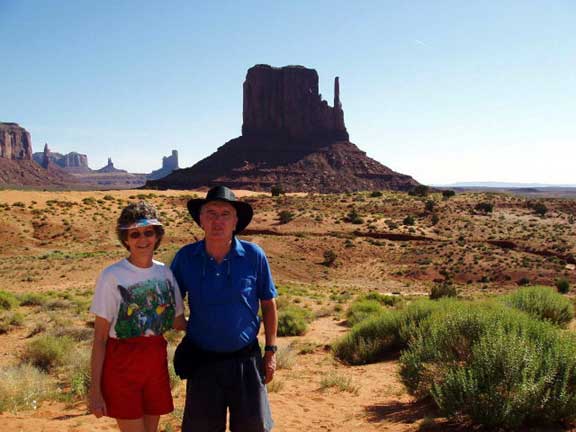 land of John Ford movies is even more striking in living color. We stayed at Goulding’s RV Park, which is part of the huge Goulding’s Lodge just five miles from the entrance to Monument Valley. A married couple settled a trading post here in 1924, coaxed John Ford to make movies here and built their own little empire. They are now both dead, but the lodge and a museum of their personal effects along with movie memorabilia are in the old trading post. land of John Ford movies is even more striking in living color. We stayed at Goulding’s RV Park, which is part of the huge Goulding’s Lodge just five miles from the entrance to Monument Valley. A married couple settled a trading post here in 1924, coaxed John Ford to make movies here and built their own little empire. They are now both dead, but the lodge and a museum of their personal effects along with movie memorabilia are in the old trading post.
Monument Valley itself looks just like it does in the movies–striking and stark. We drove around at sunset one night, and the monoliths were a brilliant red. The next morning when we toured the valley, the colors were much more subdued. It seemed strange to be in a place you’ve never visited before, but which seemed so familiar.
FOUR CORNERS MONUMENT
We made the obligatory stop at Four Corners Monument, the only place in the country where four states meet. A concrete marker holds the state seals of Arizona, Colorado, New Mexico and Utah. It was hot and a quick visit sufficed.
---Return to top of page---
MESA VERDE NATIONAL PARK, CO
Cortez, Colorado is the closest town to Mesa Verde National Park, so here we are again in Colorado’s National Parks. Mesa Verde is an archeological wonderland with nearly 5,000 archeological sites, including 600 cliff dwellings. The cliff dwellings are spectacular.
Cliff Palace is the largest cliff dwelling in North America with over 150 rooms and over 50 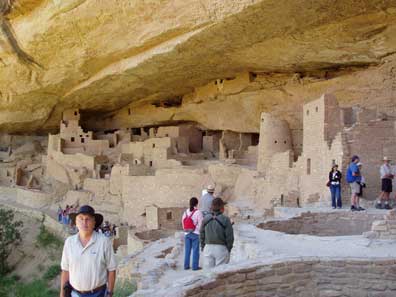 ceremonial pits. The ceremonial pits in Cliff Palace and all the other sites are amazing. They had a fire pit in the center, and on the outside they built a cold air return. The cold air came in from above, fell to the floor of the room and hit a small deflector wall in front of the vent, which sent the fresh air around the perimeter of the room. The ranger led tour is only $2.75 per person and is the bargain of the century. ceremonial pits. The ceremonial pits in Cliff Palace and all the other sites are amazing. They had a fire pit in the center, and on the outside they built a cold air return. The cold air came in from above, fell to the floor of the room and hit a small deflector wall in front of the vent, which sent the fresh air around the perimeter of the room. The ranger led tour is only $2.75 per person and is the bargain of the century.
The builders of these 13th century structures had been in the valley since about 500 A.D. where they first built subterranean pit houses. From about 750 to 1100 A.D. they constructed larger masonry structures around open courts, which we now call pueblos. Around 1200 these people moved into the alcoves of the canyon and built the cliff dwellings. During this time from 750, they sustained life through farming and hunting. They grew corn and beans and squash in this hostile environment and then stored it in specially prepared rooms. About 1276 a 24 year drought struck the land and drove the inhabitants out, and they either became, or merged with, modern Pueblo Indians. The similarity in their baskets and pottery makes archaeologists certain of the connection.
Visitors to the park were from all over the world. We heard German, French, Spanish, Japanese, and I think Russian, plus other languages I couldn’t identify. There was one family with three children who were particularly difficult to understand–I’m thinking Mississippi. Anyway, apparently the value of the dollar to the EURO and other foreign currencies has attracted visitors to our wondrous places in the U.S.
---Return to top of page---
SQUARE DANCE NATIONAL CONVENTION - DENVER, CO
We pulled into an RV park just outside of Colorado Springs where we had stayed last year and parked to enjoy their activities. We just watched movies on their big screen TV and holed up in our motorhome reading books while it rained outside. It was a good thing we had visited the sights in the area last year, because the weather was really wet.
We drove the short distance into Denver on Sunday before the convention started, and pretty much did what we had done in Colorado Springs for a few days. Wednesday night the dancing began, and we didn't rest again. It was great to reunite with friends from California, Washington, Nevada, North Dakota, Colorado, Missouri, and Texas. Less than 9,000 dancers attended this convention, but we enjoyed dancing to callers from around the states and Canada that we seldom see. We tasted humility when we tried our newly learned level of dancing to the likes of Mike Jacobs and Randy Dougherty, but we loved it all. We'll be ready to do it again in Portland, Oregon next year. Tired and sore we limped out of Denver on Sunday and headed north and east.
---Return to top of page---
SOUTH DAKOTA SIGHTS
MOUNT RUSHMORE NATIONAL MONUMENT - KEYSTONE, SD
Twenty-nine years ago we visited Mount Rushmore and the Crazy Horse Monument. The mountain sculpture at Rushmore remains majestically the same, but a new visitor center which opened in 1994 has greatly changed the way you view the monument. The huge amphitheater was a great place for the inspiring ranger talk and evening show. We sat next to a cranberry farmer from Bandon, Oregon who was thrilled we knew his little town and its lighthouse.
 Gutzon Borglum, the sculptor of Mt. Rushmore, was born in the territory of Idaho, the son of Danish immigrants. He studied art in San Francisco, and Paris where he was influenced by Rodin. His work on the initial sculpture at Stone Mountain, Georgia gave him the skill necessary to sculpt on the scale necessary at Rushmore. He was recruited for carving the mountain by South Dakota state officials who wanted a memorial to Western heroes. Borglum chose instead four presidents–Washington for the founding principles of our nation, Jefferson for the Declaration of Independence and the Louisiana Purchase, Lincoln for preserving the country during the Civil War, and Roosevelt for expansion through the Panama Canal and conservation of our natural resources. Borglum worked for 14 years until his death in 1941 fighting to do the sculpture around cracks in the granite mountain. His blasting methods enabled the monument to be created. His son, Lincoln, had worked on the mountain during Gutzon's absences, and he finished work on the mountain six months after Gutzom's death. The original plan to carve the presidents down to the waist was abandoned due to the difficulties encountered. Gutzon Borglum, the sculptor of Mt. Rushmore, was born in the territory of Idaho, the son of Danish immigrants. He studied art in San Francisco, and Paris where he was influenced by Rodin. His work on the initial sculpture at Stone Mountain, Georgia gave him the skill necessary to sculpt on the scale necessary at Rushmore. He was recruited for carving the mountain by South Dakota state officials who wanted a memorial to Western heroes. Borglum chose instead four presidents–Washington for the founding principles of our nation, Jefferson for the Declaration of Independence and the Louisiana Purchase, Lincoln for preserving the country during the Civil War, and Roosevelt for expansion through the Panama Canal and conservation of our natural resources. Borglum worked for 14 years until his death in 1941 fighting to do the sculpture around cracks in the granite mountain. His blasting methods enabled the monument to be created. His son, Lincoln, had worked on the mountain during Gutzon's absences, and he finished work on the mountain six months after Gutzom's death. The original plan to carve the presidents down to the waist was abandoned due to the difficulties encountered.
CRAZY HORSE MONUMENT - CUSTER, SD
The Crazy Horse Monument has progressed somewhat since 1975, as they unveiled the face of Crazy Horse in 1998--the 50th anniversary of its beginning. The sculptor, Korczak Ziolkowski, died in 1982, not long after our visit. His wife and seven of his ten children continue the effort, which I am fairly certain will never be completed unless some huge foundation takes it over, funds it and provides LOTS of manpower. It was a huge undertaking and a somewhat “crazy” (pardon the pun) dream. If you dream, you might as well dream BIG. If it ever were to be finished, it would be spectacular.
DEADWOOD, SD
But, if you want to talk about changes, let's talk about Deadwood. This little town whose claim to fame was that Wild Bill Hickok was shot here had a major facelift, and its all due to, you guessed it, Gambling. By the 1980's, the town of Deadwood was in a terrible state of disrepair, and in 1988 the town decided to survive it should open some casinos to get money to preserve the town landmarks. Well, they raked in the dough, and the town is looking pretty spiffy. The casinos are in the old buildings along main street, so you don't have any behemoth dwarfing the little western town. Lots of shops and restaurants as you would expect.
Boot Hill Cemetery on the hill overlooking Deadwood is the site of the adjoining graves of Calamity Jane and Wild Bill Hickok. Her crush on him during life didn’t spawn any relationship, but since she died after he did, she arranged to be buried next to him. Interesting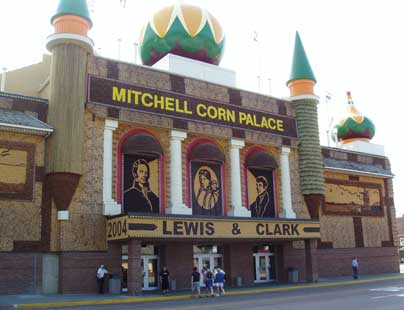 love story! love story!
MITCHELL, SD - THE CORN PALACE
With a final stop in Mitchell, SD we visited the famous Corn Palace, which this year depicted murals of the Lewis and Clark Journey of Discovery in this Bicentennial Celebration. I know its hokey, but this huge building decorated inside and out with over 2,000 bushels of corn and 40 tons of other grains is pretty fascinating. Eleven different shades of corn (who knew?) are used for the designs. This deserves a stop if you are on I-90, if only for the ingenuity, if nothing else.
---Return to top of page---
|
July
Minnesota & Wisconsin
Illinois
Niagara Falls, NY
Lewiston, NY
Cooperstown, NY
Schenectady, NY
Albany, NY
New Brunswick
Bay of Fundy
St. John
St. Martins
Fundy Trail & Natl Park
Cape Enrage
Hopewell Rocks |
MINNESOTA-WISCONSIN DRIVE THRU
A brief overnight stop in Minnesota, and we were driving through the lush hills and farms of Wisconsin. We drove past the Wisconsin Dells and saw a billboard for the resort where we honeymooned in Baraboo. Minnesota and Wisconsin are delightful to drive through, so lush and green. I really sound like someone who has been in California and Arizona too long when the sight of multiple shades of green along the road can elicit oohs and aahs. And the farms in these states are so spiffy. They are freshly painted, have well maintained barns and silos, and their yards are nicely appointed. So many farms along other roads are in varying states of disrepair.
ILLINOIS STOPOVER
A two night visit with a friend in Illinois near Rockford was most enjoyable. We caught up on our life events, talked about our children and grandchildren, and reminisced about high school days, events and people. We've been friends for over 50 years, and its always nice to recharge batteries like that. Ray actually knew her longer than I did. He dated her before me.
PETAL TO THE METAL TIME!
After our brief visit, it was on to I-90, the Indiana Toll Road, the Ohio Turnpike, the Pennsylvania Turnpike and the New York Thruway. A traffic jam in Indiana, just east of Chicago, prompted us to turn on the CB Radio to see what we could learn. The truckers always keep you amused, but they usually can find out what causes the tie-up and what lane to get into to keep moving. Course the fact that they hold up folks in their lane to let four and five trucks ahead of them doesn't help our progress any. And you folks who like to cut them off, think twice. One guy was complaining about a little Mercedes, and another trucker said he saw them and did the other guy want him to give them his “regards.” Remember when you're on the road, these drivers talk to each other all the time!
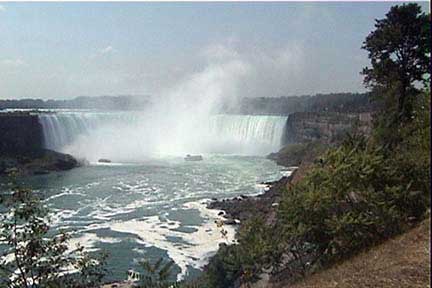 NIAGARA FALLS, NY NIAGARA FALLS, NY
Soon we were once again at Niagara Falls, and back at places which were the locales for battles of the Revolutionary War and the War of 1812, when the western places with which we are now more familiar didn’t even have names in the history books. We visited Niagara just two years ago on the Canadian side. I forgot you couldn’t really see much from the American side (last time was thirty years ago). In addition to the spray from the falls, it rained and soaked us through. We were at Horseshoe falls, which is really wet all the time. We didn’t know it was raining until we got a distance from the falls and realized the spray couldn’t be following us that far. Anyway, the falls were spectacular, but our photos from 2002 are better than those we got this time.
LEWISTON, NY
Every little town has historical markers of battles and heroes. Fort Niagara was originally a British Fort which was surrendered to the Americans in 1796. In the town of Lewiston we stood on the bank of the Niagara River and read about a battle there in the War of 1812 where 90 Americans and 130 British were killed on one day, and 1000 Americans were taken prisoner. How on earth did they have that many people roaming around up there? Actually, the border was a strategic area, and the Americans apparently blew it.
COOPERSTOWN, NY
Next stop, Cooperstown, NY, and the Baseball Hall of Fame which Ray wanted to visit. I was more interested to learn that Cooperstown was founded by Judge William Cooper, the father of James Fenimore Cooper. He owned a vast tract of land on the Susquehanna River and built a mansion on Otsego Lake, which is where the young Fenimore grew up. The countryside here is possibly much the same as it was when he wrote The Last of the Mohicans. It is still heavily wooded, except where there are clearings for home and/or farms. No one has cleared entire areas, and the homes have clumps of trees in various spots and usually surrounding their yards. Rivers, lakes and streams crisscross the hilly roads, and if you look carefully you can almost see Hawkeye, Chingachgook and Uncas running alongside you once in a while. And perhaps around the next turn in the road is the evil Magua. Guess you can tell I am a Cooper fan. I fell in love with these particular characters when the forerunner to BBC's Masterpiece Theater did a series loosely based on the novel which aired on PBS maybe in the 1960's. I missed the two silent versions (1911 and 1920), and the 1932 serial. Of five film versions with sound, I've seen the 1962, 1977 and 1992 versions. I loved the 1992 Daniel Day-Lewis film, especially the scenery, which was shot in the Carolinas, not New York.
---Return to top of page---
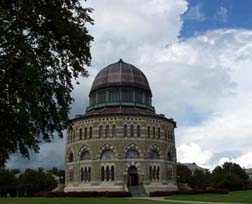 SCHENECTADY, NY SCHENECTADY, NY
Following the course of the Mohawk River, we visited the Dutch village of Schenectady founded in 1661. Driving through the city reminded me of Chicago in the 1940's. While the town includes many buildings dating from 1700 to 1850, most of the ones we saw seemed to be more of the 1900-1920's vintage. The brick facades hugged the narrow sidewalks next to the streets, and the yardless neighborhoods looked like those in Bridgeport in Chicago. The gem of our visit was Union College. It was founded in 1795 and was the first architecturally designed campus in the country. It reminded me of Rosary College where I went to school. The campus was lush and green with gardens and pathways leading to buildings that were freshly painted and majestic. As we parked in a permit only empty lot, a man approached us and said we were possibly safe from towing. He asked if we were alumni also. His license plate was Florida, and this was his first visit since 1971. He steered us toward the newly restored circular building. This beautiful building is on the list of National Historic Sites.
ALBANY, NY
Since we are always ready to tour capitols, we decided to make a stop in Albany. This capital city was chartered in 1686 but had been a Dutch trading post in 1609, following the French trappers who had been in the area in the mid 16th century. Four U.S. presidents--Van Buren, Fillmore and both Roosevelts. Both Herman Melville and Henry James were citizens of Albany. It is a modern city that reeks with history. While this is common in other parts of the world, it is not as usual here in the U.S.
The huge domeless capitol was built in the late 1800's. Five architects worked on it over the thirty year period in which it was built. The building looks like the houses of parliament with two huge wings and at least five different styles of architecture within. One of the three staircases has Romanesque arches, another has gothic arches, and the third, known as the million dollar staircase, is designed after the one in the Paris Opera House. The one at the Opera House is gorgeous, but this one is just ornate and heavy looking. Everything in the building is dark and heavy. has Romanesque arches, another has gothic arches, and the third, known as the million dollar staircase, is designed after the one in the Paris Opera House. The one at the Opera House is gorgeous, but this one is just ornate and heavy looking. Everything in the building is dark and heavy.
Connected to the Capitol Building via an underground concourse is the Rockefeller Empire State Plaza, which houses a terrific state museum. We could have spent a lot more time there than we had allotted.
---Return to top of page---
NEW BRUNSWICK, CANADA
We drove north up the Maine coast, stopped a few nights en route, and then entered New Brunswick through St. Stephens. For the last ten days we have been exploring the coastline of New Brunswick on the Bay of Fundy. Our first five days were in Pocologon, which is between St. Stephen and St. John. We were just across the road from the bay coast and enjoyed walks there when it wasn't too foggy to see the water. We drove the coastal route around us and checked out the various harbors at high and low tides.
The Bay of Fundy is a funnel shaped bay between New Brunswick and Nova Scotia, and it is because of this shape that the highest tides in the world exist in this spot. At some places it reaches 42, 52 or 56 feet, depending on who is writing or talking about it. I don't know how high they are, but they are fascinating. The story of their formation is the god, Glooscap, wanted to take a bath, so he instructed the beavers to build a dam at the mouth of the bay. When they did this a whale came by and was angry at the blockage, so he pounded his tail on the dam repeatedly making the water slosh back and forth as it would in a bathtub, and that has continued to this day.
ST. JOHN, NB
During our visit to St. John we learned what happened to all those British who remained loyal to the crown during the American Revolution. They moved to New Brunswick. Seems over 8,000 Loyalists took up residence in this city after our Revolution. They have the Loyalist Cemetery and the Loyalist House. The oldest farmers market in North America sits in downtown St. John. In 1876 they covered the market, and since the carpenters were all shipbuilders, the interior roof looks like the hull of a ship. It survived a devastating fire the year after it was opened and is a bustling place now. Restaurants dot the walls, and produce vendors are in the center.
ST. MARTINS, NB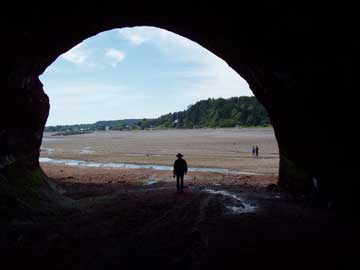
From St. John we traveled to St. Martins, a pretty village on the coast where we were facing the bay. In St. Martins the tides have carved huge sea caves out of the red sea cliffs. At low tide we walked in and around the caves, and at high tide kayaks guide tourists in and around the caves. St. Martins, originally known as Quaco, was a shipbuilding center for about 100 years until the mid 1880's. The towns homes reflect the prosperity of these shipbuilders with their elaborate architectural details. An automated lighthouse has replaced the original one which burned down in 1968, but a replica was built and is now the Visitor Center. Twin covered bridges add to the town's appeal. Everyone was very friendly, and nothing was crowded.
FUNDY TRAIL
Just East of St. Martins is the Fundy Trail, a nature area with trails leading to hidden waterfalls , the Salmon River, and a suspension bridge. William Randolph Hearst had a family lodge here, but the hike to it was described as “challenging” and was several miles long. I’ll revisit San Simeon if I want tales of the old guy.
FUNDY NATIONAL PARK, ALMA, NB
Fundy National Park is a bigger version of the Fundy Trail with more coastline, more waterfalls, rivers, lakes and forest. We walked the coastal, waterfall and forest trails. The covered bridge was painted a barn red in contrast to those outside the park which are badly in need of paint. The suspension bridge was sufficiently scary when other people were on with you. The limit is listed as ten people, but I seemed to be the only one counting. The area of the park was formerly a logging and sawmill site, so that history is documented at their interpretive center.
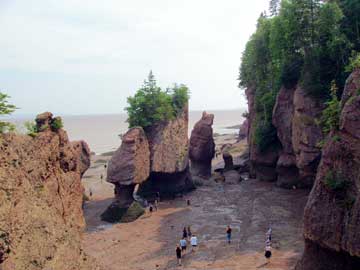 CAPE ENRAGE, NB CAPE ENRAGE, NB
On the trail of another lighthouse we drove to a foggy place on the coast. The automated lighthouse was playing its mournful fog horn while we visited. This lovely spot was in disrepair and several years ago a local high school's students undertook to repair it. Now they run the entire site which includes a restaurant. The students live on site during the summer, and a foundation apparently is in charge of overseeing the whole thing.
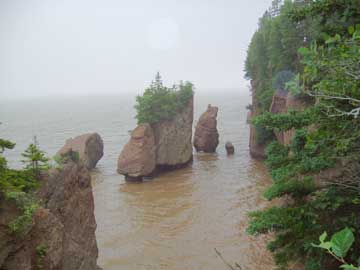 HOPEWELL ROCKS, HOPEWELL CAPE, NB HOPEWELL ROCKS, HOPEWELL CAPE, NB
Here at Hopewell Cape the tides of Fundy have carved more caves, but additionally they have carved pillars of sandstone which stand alone on the shore, and at their top balsam fir and dwarf spruce trees are growing. When it is low tide, you can walk the ocean floor around the base of these pillars, and at high tide they look like little islands. They are called the Flower Pot Rocks and at high tide that is exactly what they look like.
---Return to top of page---
|
August
Prince Edward Island
Cavendish, PE
Charlottetown, PE
Kensington, PE
Summerside, PE
Nova Scotia
Amherst, NS
Pictou, NS
Ceilidh Trail
Bras d’or Trail
Cabot Trail
Glace Bay, NS
Louisbourg, NS
Fortress of
Halifax, NS
Peggy's Cove, NS
Campobello Island, NB |
PRINCE EDWARD ISLAND
We drove from Hopewell Cape east to the Northumberland Strait that separates New Brunswick from Prince Edward Island. There we drove across the nine mile long Confederation Bridge to the island. The bridge was opened in 1997 and is quite a structure. No swinging like the Golden Gate here, but solid concrete pillars hold this massive structure. Unlike crossing into San Francisco, you pay on the way back. Good idea to put the money aside so you can get off the island. The toll is about $45.00 Canadian for our RV and car, but that is less than the ferry would have been, so guess we can't complain.
LIGHTHOUSES AND BEACHES, PE
This island, since it is an island, is a lighthouse aficionado's paradise, with over fifty on the shores. We drove to the shore of the Gulf of St. Lawrence and were rewarded with miles and miles of beautiful sandy beaches and the bluest water this side of the Caribbean. Sunday was warm and sunny, and the beaches were packed with people enjoying the day. As we walked back from one lighthouse, I spied a huge red blob on the road near the water. It was one of the Asian Jellyfish that have a nasty sting and live in the surrounding waters. Yuck!
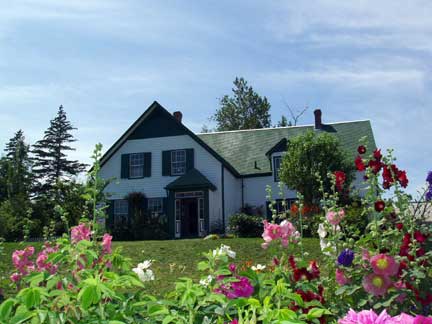 CAVENDISH, PE CAVENDISH, PE
On the north end of the island near the gulf sits the village of Cavendish, which is the town Lucy Maud Montgomery called Avonlea in her Anne of Green Gables books. The house she described in the books was near the farm where she grew up, and it is now a National Historic Site that is in Prince Edward Island National Park. We visited the house and walked the trails through the woods around it. It was an enjoyable afternoon.
CHARLOTTETOWN, PE
This Provincial Capital town has a population of under 40,000 but is the largest city on PE Originally settled as a French post in 1720, the town held political meetings in 1864 which laid the seeds for the formation of Canada three years later. We visited Province House, where the meetings in 1864 were held, and where the Legislature still meets. The building has been restored to reflect the 1860's period, and the Legislature's meeting room looks just that archaic and uncomfortable.
St. Dunstan's Catholic Basilica has a gothic marble interior with a heavy brick exterior built in 1898, but it looks sturdy enough to stand another few hundred years. Several other churches were built in the square set aside for churches and government buildings. We attended Mass there on the weekend.
Performers from the Confederation Centre of the Arts performed music and dancing on an outdoor stage. They did Acadian songs and dances, Celtic step dancing, and what I would say was the Canadian equivalent of clogging. The young people studying there were from all over Canada and were quite talented.
---Return to top of page---
KENSINGTON AND CLINTON, PE
Visited a tourist trap in Kensington then another lighthouse in a delightful little village. Decided to stop at the famous St. Ann's Church Lobster Supper in Clinton, PE. This little Catholic Church had a resourceful pastor in 1963 who wanted to pay off the $35,000 parish debt and decided to serve lobster dinners in the church basement once a week to raise the money. Well, 40 years ago in 1964 the dinners were served for $1.50 each. The idea caught on, and now they serve 25,000 dinners per tourist season and employ about 60 locals to work in the church basement Tuesday through Saturday. The price has gone up a little. A dinner starts with freshly made seafood chowder (mostly lobster), followed by a huge plate of mussels and melted butter, then a salad and roll, a one or one and a half pound lobster, some new potatoes from PEI, a beverage, and your choice of about six delicious desserts. The price for all this is under $30.00 Canadian. You can also get various other entrees, but why would you? Anyway, I can't believe I ate the whole thing. I chose the lemon meringue pie for dessert and ate that too. Ray had the catch of the day and some coconut cream pie which he thoroughly enjoyed. Oh, and they paid off that parish debt!
It was billed as Fiery Faith and Fiddles and was a very interesting show. In a little wooden firetrap of a barn adjacent to a small hotel, the evening show was put on by four members of the same family – father, daughter and two sons. Not joining the show that night were the wife and another son and daughter. The faith part is the Unashamed Ministries, and they spoke a little about that, did some Bible readings before most numbers and were incredibly multi-faceted and talented. The father played piano wonderfully, the guitar and the violin. An older son played piano, a little, the violin really well, and was great on the sax. A younger son played the guitar and step danced with the youngest, a girl. She also was an accomplished pianist. They did two jazz numbers with the kid on the sax and were really good. Okay, by my kids’ and granddaughter's standards they were definitely dorks, but they were very happy in what they were doing, and did it well. The older son is a junior at the Baptist college and is busking playing the violin in downtown Charlottetown to earn enough money to purchase an engagement ring for a girl he has fallen for. The father seemed to be proud his son was playing violin on a street corner with a photo of his intended and a picture of a diamond ring. Call me tough, but I would have told him to get a job and earn the money. To each his own.
SUMMERSIDE, PE
In this town whose name describes it perfectly is the College of Piping, which is the only such institution on this continent, as a matter of fact there is only one other in the world--and it is located in Glasgow, Scotland. They teach Celtic and Highland dancing and music including bagpipe, snare drums, step dancing and highland dancing. We learned how bagpipes work, that snare drums weigh thirty pounds, and the difference between Irish step dancing and Highland step dancing. So, if it ever comes up in conversation, I'm ready.
SQUARE DANCING
On our way back from church on Saturday evening I spied a square dance symbol (interlocked squares) on an arrow on a post. We followed it to another such arrow and eventually got to a place that said they were having their jubilee that evening. It was seven o'clock already, and the dance was at eight. We rushed back to the RV park, grabbed some duds and were back by about 8:15. It was mainstream/plus, but we were in withdrawals and enjoyed meeting folks from PEI, New Brunswick and Nova Scotia. Everyone was delighted we had been visiting so much on the island, and they were helpful in telling us other places to visit there and in Nova Scotia. Always nice to mingle with the natives.
---Return to top of page---
NOVA SCOTIA
We traveled from Prince Edward Island to Nova Scotia through New Brunswick in very quick time. You just make a left after leaving the Confederation Bridge, and you are practically in Nova Scotia or New Scotland as it is translated from Latin.
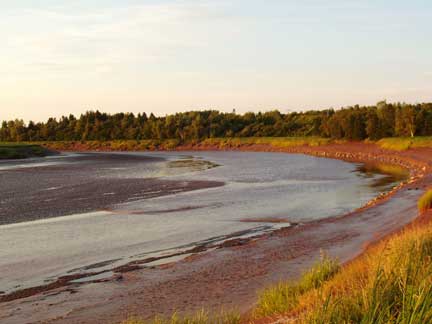 AMHERST, NS AMHERST, NS
Just down the road from the RV Park in Amherst we visited a place where a Tidal Bore takes place. This is a phenomenon which causes a river to reverse its course at high tide. When we arrived at the tiny parking lot for viewing the tidal bore there was one car already there. He was English, she was a New Yorker, and they lived in Ontario. Just a few minutes later another car arrived with one man who lived across the road. He was possibly in his late seventies or early eighties and just came to talk to us about the tidal bore. He explained the whole process and showed us just where to get the best view. The high tide was due at 7:55 p.m., and we watched as the water came in and met the river water. Then a little brown squiggly wave began to form at their juncture, and slowly the wave returned in the direction where it had just entered. It grew as the volume of water increased. It was sort of fascinating to watch the whole thing take place at such a precise time, unlike watching grass grow which is hardly ever on a timetable.
PICTOU, NS
Pictou is sort of the Plymouth Rock of the Scots of Nova Scotia. In 1767 the Philadelphia 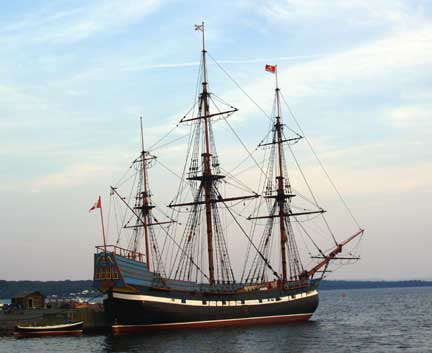 Company, which included Ben Franklin as a shareholder, sent six families to settle some land they owned in Pictou. Four families later moved away, but in 1773 the new agent for the Philadelphia Company offered free passage, a farm lot and a year's provisions to citizens of Scotland for settling the new land. Subsequently thirty-three families and twenty-five single men boarded the Ship Hector and sailed to Nova Scotia. This was the beginning of the Scottish migration. Company, which included Ben Franklin as a shareholder, sent six families to settle some land they owned in Pictou. Four families later moved away, but in 1773 the new agent for the Philadelphia Company offered free passage, a farm lot and a year's provisions to citizens of Scotland for settling the new land. Subsequently thirty-three families and twenty-five single men boarded the Ship Hector and sailed to Nova Scotia. This was the beginning of the Scottish migration.
In 1990 the citizens of Pictou needed something to attract tourists to their town and decided to built a replica of The Hector as the centerpiece for their revitalized town and waterfront development program. Over a ten year period the ship was built by citizens of the town and finally launched in 2000. The waterfront now has a nice boardwalk, several restaurants and hotels.
CEILIDH TRAIL
The Tourism Bureau or some other bureau has divided all of Nova Scotia into various trails. They are like the Scenic Route signs you see in the U.S., but here they have the entire Province marked into trails. While there is really a great deal to see, the flaw in the system is that lots of times a small town is just that, a small town. Knowing this, however, we have followed the trails. The Ceilidh Trail, (pronounced kay-lee) runs along the western coast of Cape Breton Island and follows Scottish and Gaelic settlements there. The rugged coastline 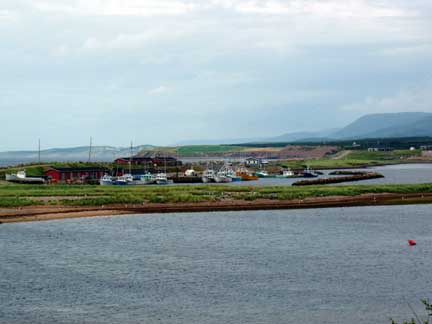 scenery boasts lighthouses and beaches along the way. Margaree Harbor is a picturesque town, and Mabou has an old lighthouse. scenery boasts lighthouses and beaches along the way. Margaree Harbor is a picturesque town, and Mabou has an old lighthouse.
---Return to top of page---
BRAS D'OR TRAIL
This trail takes you around the inland lakes of Cape Breton, their harbors and villages. We stopped for tea in Big Pond at Rita's Tea Room owned by a Canadian Folk Singer. It is a tour bus stop, but the tea room was delightfully English.
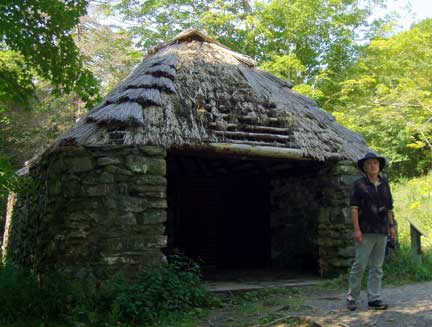 In Iona we visited the Highland Village Living History Museum. These museums are quite plentiful throughout the U.S. and Canada, but sometimes they have something that appeals to us, as did this one. It was interesting to see the Black House of 18th century Scotland--a stone building with a sod roof. The other buildings had been moved to the site for the museum and were constructions from 1810 to 1920. The church just arrived last November, and they had photos of it being transported via various means, including on a barge in the lake. In Iona we visited the Highland Village Living History Museum. These museums are quite plentiful throughout the U.S. and Canada, but sometimes they have something that appeals to us, as did this one. It was interesting to see the Black House of 18th century Scotland--a stone building with a sod roof. The other buildings had been moved to the site for the museum and were constructions from 1810 to 1920. The church just arrived last November, and they had photos of it being transported via various means, including on a barge in the lake.
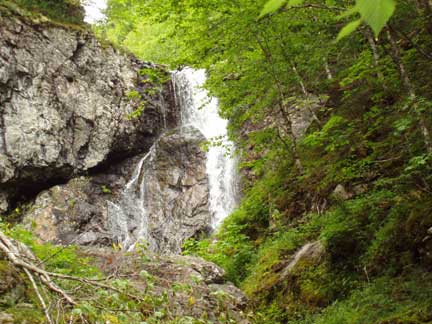 Ray found waterfalls we could hike to on the trails and even one just outside of Baddeck where we stayed for five days. He has a fascination for waterfalls, so we follow every sign we see to one. Of course, in August, sometimes you just get to see a trickle. Ray found waterfalls we could hike to on the trails and even one just outside of Baddeck where we stayed for five days. He has a fascination for waterfalls, so we follow every sign we see to one. Of course, in August, sometimes you just get to see a trickle.
CABOT TRAIL
It rained the day we planned to take the 186 mile Cabot Trail, so we stayed in and read books. The following day was sunny, so we embarked on the road to the northernmost part of the island and Cape Breton Highlands National Park. The road takes you up the west coast overlooking the Northumberland Strait and opposite PEI, you continue to North Point along the Gulf of St. Lawrence, then the trail returns down the east coast along the Atlantic. It is described as one of the most beautiful scenic drives in the world, and it has really spectacular sights. We drove the car, while the motorhome stayed safely in the RV Park in Baddeck, which was definitely a wise thing to do. The road is narrow and bumpy, and the area is even more sparsely populated than the rest of the Maritimes. Folks up there are really remote.
GLACE BAY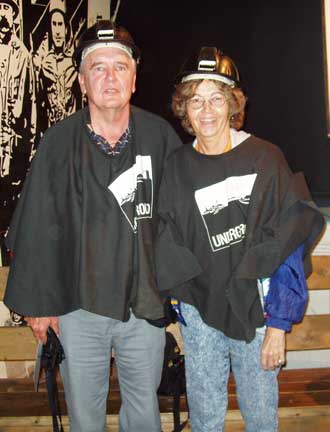
In 1720 French troops dug coal from the cliffs of this town to heat the garrison at Louisbourg, and the coal mine tunnels extend miles into the Atlantic and yield bituminous coal which is still used widely in this part of Canada. The Coal Miners’ Museum has a fascinating, if backbreaking, tour of an actual mine. The guides are retired coal miners, and you don a hard hat and black cape to go into the mine. The ceilings are as high as 5'6" and as low as 4'6", so there is a lot of bent-over walking. The hard hat saves bumping your own head on the very low beams and acts as an umbrella for the dripping ceilings. Our tour guide was a jovial retiree who went to work in the mines in the 1970's when conditions were much better than were described on the tour, but nevertheless they were appalling. Think of all the books and movies that have been made about the plight of coal miners, and then consider they were understated. What a ghastly way to eke out a living!
But Glace Bay's notoriety is not limited to the plight of coal miners. It was on the shore of this community that Marconi sent the first west-to-east trans-Atlantic wireless message in 1902. There is a National Historic Site displaying models of his transmitter and telling of his accomplishments.
---Return to top of page---
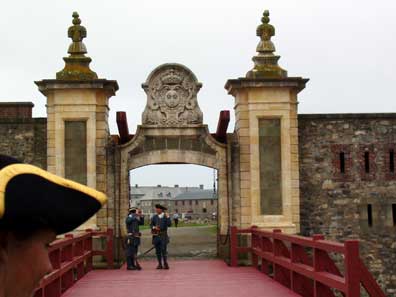 LOUISBOURG, NS LOUISBOURG, NS
French settlers arrived at this harbor in 1713, two hundred and ninety-one years before we drove into the town operated RV park right on the harbor. The day was sunny, windy and absolutely gorgeous. This was the center of the French colony that included Cape Breton and Prince Edward Island until 1758. Now just outside this tiny town is a reconstruction of the massive fortress built by the French to defend its colonies.
FORTRESS OF LOUISBOURG, NS
A visit to this National Historic Site of Canada takes a step back in time to 1744. With the possible exception of well hidden telephones and a few modern bathrooms, the fortress is pure 18th century. The residents of the village represent all classes of society and are ready to converse with you and answer any questions you might have. We took a two-hour guided tour and then explored on our own the remainder of the day.
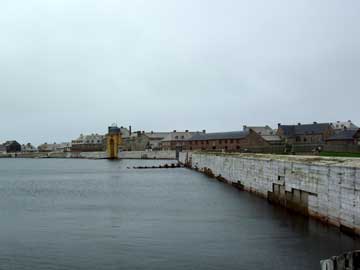 Twelve acres which include over 50 buildings have been reconstructed according to the original specifications in building the fortress. Over three million pages of original document from French records were used to erect the fortress. Only nails, locks and railings made onsite by the blacksmiths were used in the building. The French were so anal that they specified where the nails in the city gate were to be placed, and this was authentically replicated. Twelve acres which include over 50 buildings have been reconstructed according to the original specifications in building the fortress. Over three million pages of original document from French records were used to erect the fortress. Only nails, locks and railings made onsite by the blacksmiths were used in the building. The French were so anal that they specified where the nails in the city gate were to be placed, and this was authentically replicated.
While I'm thinking about nails, the military blacksmith demonstrated making a nail while we were there and gave it to Ray to “take back to Arizona.” The blacksmith was a particularly knowledgeable fellow about the entire fortress’ history.
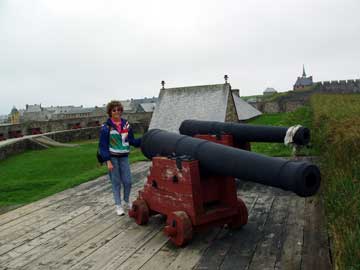 We had lunch at one of the three restaurants where only pewter dishes and utensils were used. Everyone was seated at wooden benches with huge towel-like napkins. We had some split pea soup and bread made at one of the bakeries. The soup was tasty, and the bread was a very heavy dark bread, the kind the soldiers would get in their weekly rations. They got about a six pound loaf, which would get very hard after a few days, so they needed to dip it into some liquid to soften it in order to eat it. Anyway, back to our lunch. The pewter spoons with our soup were huge, and when the woman next to us inquired about a spoon for the open bowl of raw sugar for her tea, the waitress showed her how to use the handle end to scoop some sugar. Didn’t seem very sanitary to me. We had lunch at one of the three restaurants where only pewter dishes and utensils were used. Everyone was seated at wooden benches with huge towel-like napkins. We had some split pea soup and bread made at one of the bakeries. The soup was tasty, and the bread was a very heavy dark bread, the kind the soldiers would get in their weekly rations. They got about a six pound loaf, which would get very hard after a few days, so they needed to dip it into some liquid to soften it in order to eat it. Anyway, back to our lunch. The pewter spoons with our soup were huge, and when the woman next to us inquired about a spoon for the open bowl of raw sugar for her tea, the waitress showed her how to use the handle end to scoop some sugar. Didn’t seem very sanitary to me.
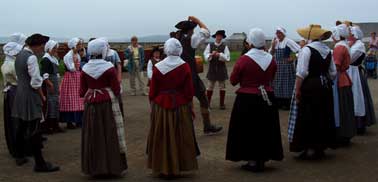 A guitar playing entertainer gathered a ring of children and townsfolk around and lead them in a rousing rendition of alouette, which everyone enjoyed. A guitar playing entertainer gathered a ring of children and townsfolk around and lead them in a rousing rendition of alouette, which everyone enjoyed.
The largest building by far was the King's Bastion which housed the military barracks and weaponry. In 1744 it was one of the largest buildings in North America, course there weren’t a lot of other huge buildings. A lovely chapel was large enough that the town's priest said they didn’t need to build a church.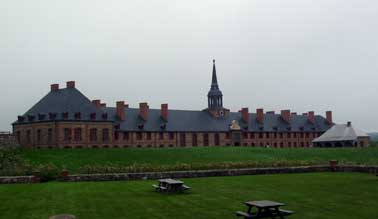 The French influence was even more evident here than in the rest of the town. The French influence was even more evident here than in the rest of the town.
There was a clock on the King's Bastion, but it was a single hand clock, and I couldn’t make it out. Later in the day I noticed it hadn’t moved, so that didn’t help either. Anyway, the townsfolk didn’t need a clock because the drums and pipes throughout the day indicated what time it was. A contingent of drummers and pipers paraded through town several times and like the Pied Piper, folks would follow them. One time they led to a canon and musket demonstration, another time to a public punishment. They didn’t seem to put folks in jail, but an offender would have his/her crime written on a wooden tag, be paraded through town, and then made to stand for several hours in irons in town.
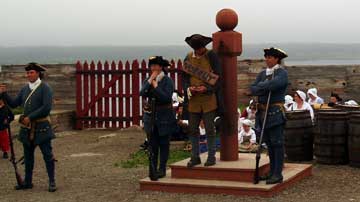 Prisoner on display with crime on chest
Prisoner on display with crime on chest
|
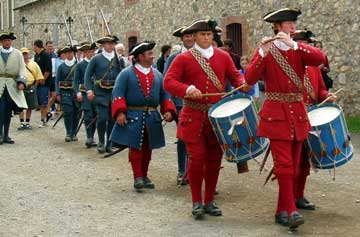 Piper and drummers
Piper and drummers
|
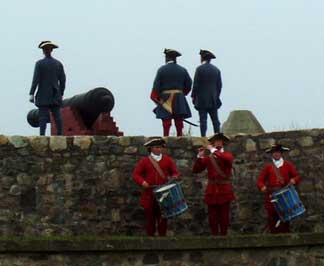
Preparing to shoot canon
|
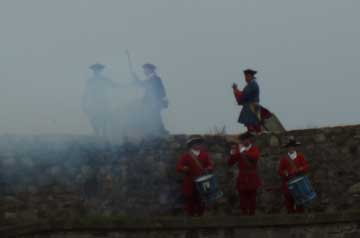 Smoke following canon fire
Smoke following canon fire
|
A fortress differs from a fort in that it houses an entire town which included families and lots of civilians. I didn't know that before this visit, so I just thought I'd throw it in here. Louisbourg harbor was an ideal location because it didn’t freeze and was a convenient Atlantic seaport for access to France and for the French privateers who preyed on New England shipping. Well, the British empire didn’t take kindly to some of its antics, and in 1745, after a 47-day siege, New Englanders captured Louisbourg and sent its residents back to France.
Three years later, it was returned to France by the Treaty of Aix-la-Chapelle, and then in 1758 it was captured again, and its residents once again returned to France. The British tried living there, but the fierce Nova Scotia winters were too much for them. They had lost only 100 men in the two sieges, but 1000 died from 1758-1760. In 1760 British prime minister William Pitt ordered the fortress destroyed, and the Brits blew it up.
Anyway, we enjoyed our day in 1744.
---Return to top of page---
HALIFAX, NS
The capital of Nova Scotia was one of the first English settlements in Canada and was founded in 1749. This probably accounts for the European feel of the city. The harbor here is the second largest in the world--second only to Sydney, Australia. Modern buildings dot the city, but we only paid attention to the historic ones. Province House, their legislature's meeting place was built in 1818. It is a tiny building, by governmental standards, which houses some huge portraits. The portraits are from the British crown and are the wall covering type that hang in England's castles. None is really a great piece of art, but the frames are spectacular.
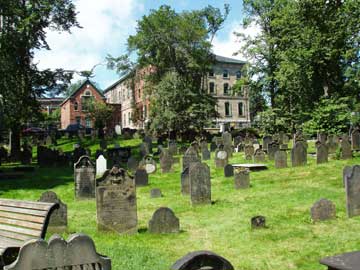 The Old Burying Ground was used from 1749 to 1844 which is pretty old for North America. A foundation recently restored the cemetery and straightened all the remaining tombstones. It sits in the downtown area with St. Mary's Roman Catholic Basilica on one border and St. Matthew's United Church on another. St. Mary's has the tallest polished granite spire in North America and was built in the mid 19th century, and St. Matthew's opened in 1859, but its congregation dates to 1749. The Old Burying Ground was used from 1749 to 1844 which is pretty old for North America. A foundation recently restored the cemetery and straightened all the remaining tombstones. It sits in the downtown area with St. Mary's Roman Catholic Basilica on one border and St. Matthew's United Church on another. St. Mary's has the tallest polished granite spire in North America and was built in the mid 19th century, and St. Matthew's opened in 1859, but its congregation dates to 1749.
Naturally, the harbor is one of the main attractions in town, and it is bustling just like San Francisco's wharf. Multiple boat tours are available, restaurants to tempt any appetite abound, and the Maritime Museum of the Atlantic holds a wealth of information. Halifax's proximity to the Titanic when it went down sent its sailors out into the Atlantic to recover bodies. While they did recover almost 200, mostly they brought back floating artifacts from the huge ship.
Then on December 6, 1917, Halifax had its own disaster which wiped out one third of the city's population and destroyed the waterfront. It was wartime, and a French munitions ship, the Mont Blanc, put into the harbor before joining a convoy. As the ship entered the harbor, it collided with a much smaller ship, the Imo, in a rush to leave. The collision caused a fire which initially set off multiple drums of TNT which created a sort of fireworks and drew spectators to the shoreline. The fire then spread to the main munitions and caused an explosion which drained the harbor, caused an earthquake and a tidal wave followed. The Imo was hurled onto the Dartmouth side of the harbor. Two thousand people were killed, most of them instantly. The city of Boston was one of the first to respond with aid, and to this day, Halifax sends a Nova Scotia Christmas tree to Boston.
The Halifax Citadel is a star shaped fort built in 1856 to defend the city from the United States. We were 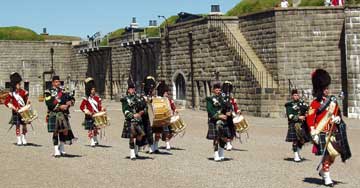 such stinkers. We never attacked it, and neither did anyone else, but it is an imposing place. The 19th century accommodations didn’t seem a great deal better than the 18th century ones we saw at Louisbourg, but maybe I was missing the fine points. The sanitary conditions in both centuries make me wonder how any of us were ever born. such stinkers. We never attacked it, and neither did anyone else, but it is an imposing place. The 19th century accommodations didn’t seem a great deal better than the 18th century ones we saw at Louisbourg, but maybe I was missing the fine points. The sanitary conditions in both centuries make me wonder how any of us were ever born.
The Citadel, being Scottish, had pipers and drummers of a Highland nature. We were entertained by a group of five snare drummers, one base drummer and four pipers, but were informed there should have been five. Believe me, four guys playing bagpipes can make more than enough noise for me, I didn’t need another one. I like the guy who led them with his big baton, though--fancy hat and cute legs. He also gave a commercial for the gift shop, which was actually pretty funny.
We arrived at the fort in time for the Noon Gun, which has been fired daily for 144 years. Throughout the grounds a Living History Unit performs drills from the British Army manuals of the period. And they do it for a long time, marching and shooting. Looked too much like the real army.
PEGGY'S COVE, NS
Peggy's Cove is a little fishing village in one of the many harbors on St. Margaret's Bay. Huge granite boulders are scattered throughout the village, and an old lighthouse stands on a granite ledge at the water. The village is tiny and picturesque. But you may remember the name from a 1998 Swissair plane crash. Swissair Flight 111 crashed, and just outside the village bodies were recovered and lined up along the water. There is a tasteful granite memorial at the site.
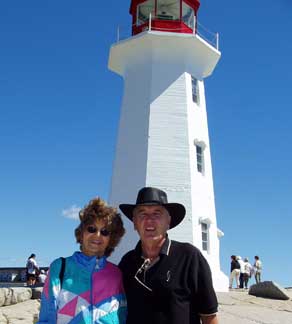
Joy and Ray at Peggy's Cove Lighthouse 8/04 |
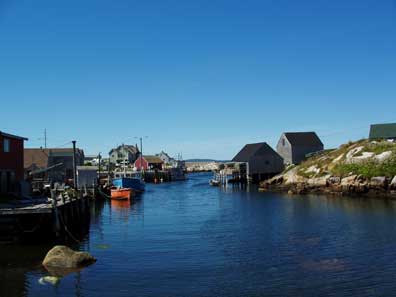
The harbor at Peggy's Cove 8/04
Did you ever see water so blue? |
---Return to top of page---
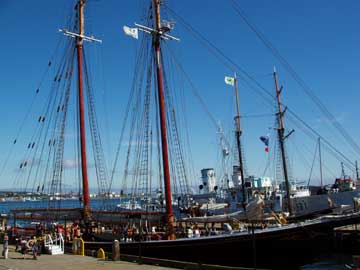 LUNENBURG, NS LUNENBURG, NS
Oliver Cromwell granted the land for this village to Charles de La Tour in 1656, and in 1751 immigrants from Hanover along with other German, French and Swiss immigrants founded this town. The Germans were predominantly farmers, but eventually they turned to the sea. Lunenburg was a shipbuilding center, and it was here that the Bluenose was built in 1921. This schooner was the undefeated champion of the North Atlantic Fishing Fleet and the winner of four international schooner races. Her fame put her likeness on the Canadian dime. The Bluenose II, also built in Lunenburg, now tours seaports, and we saw her in the Halifax Harbor.
While the town prospered, it also outgrew its original boundaries, and in the mid nineteenth century additional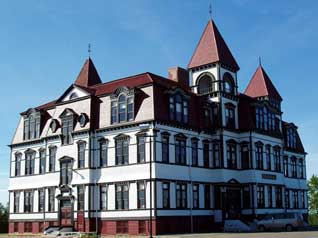 Common Land was subdivided and wealthy merchants and professionals built fashionable homes there. Hence, in 1995 the pretty town as designated a UNESCO World Heritage Site because it is an outstanding example of a planned European colonial settlement. We did a walking tour of the town and enjoyed the 18th and 19th century buildings. Atop a hill at the edge of town sits the impressive 1895 Lunenburg Academy. The wood frame structure is three stories high and is visible for many miles. Common Land was subdivided and wealthy merchants and professionals built fashionable homes there. Hence, in 1995 the pretty town as designated a UNESCO World Heritage Site because it is an outstanding example of a planned European colonial settlement. We did a walking tour of the town and enjoyed the 18th and 19th century buildings. Atop a hill at the edge of town sits the impressive 1895 Lunenburg Academy. The wood frame structure is three stories high and is visible for many miles.
---Return to top of page---
CAMPOBELLO ISLAND, NB
Our final stop in the Canadian Maritimes was Campobello Island, Franklin Delano Roosevelt's “beloved island.” We were near St. George on the New Brunswick coast so opted to take the ferries to the island. A government owned free ferry runs from the mainland to Deer Island, then after a short drive to the southern end of the island, you catch another ferry (privately owned) over to Campobello Island. In 1883 James Roosevelt first came to the island, when Franklin was just one year old. FDR spent most of his summers t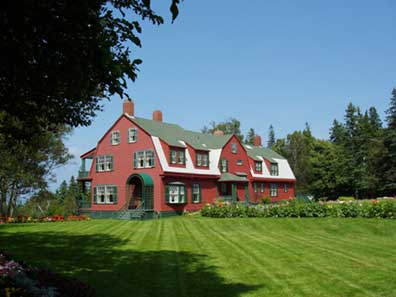 here until 1921 when he contracted polio and had to be carried off the island on a stretcher. The 34 room Roosevelt Cottage is now part of Roosevelt Campobello International Park, a joint memorial by Canada and the United States which opened in 1964. here until 1921 when he contracted polio and had to be carried off the island on a stretcher. The 34 room Roosevelt Cottage is now part of Roosevelt Campobello International Park, a joint memorial by Canada and the United States which opened in 1964.
The home had neither electricity nor telephone until the late 1950's, and though large, accommodations seemed somewhat Spartan. However, with seven to ten servants, the family wasn't exactly roughing it. Franklin and his children loved the outdoors, especially boating. Roosevelt returned to Campobello only three times after becoming president in 1932.
As I said, we took the ferries to Campobello, which worked out pretty well going there. But, on the return when we arrived at the line for the ferry back to the mainland, there was a huge line, and we didn’t make the cut on the first ferry. So, we waited another hour and didn’t think we were going to make that one, but managed to squeeze on with one car behind us. If we had driven back down the coast of Maine, we could have taken the FDR Memorial Bridge the short distance to the island. I definitely recommend the bridge, since we spent the better part of the day waiting for ferries to arrive. The novelty of the water crossing wore off by the second long wait for a ferry.
This visit has been very different from earlier visits to Canadian provinces. The Maritimes, like our New England states, are steeped in an earlier history than the west. And the Canadian European/Highland heritage is much stronger than we have experienced in the last twenty-five years. I remember how strange it seemed in California when we met people who didn’t seem to know what nationality they were. There is a sense of continuity here from ancestors across the Atlantic to early settlers to their modern day descendants.
---Return to top of page--- |
September
Bethel, ME
Bretton Woods, NH
Stratford, ON
Goderich, ON |
BETHEL, ME - BRETTON WOODS, NH
We spent some time in this little community near the New Hampshire border of Maine and drove through the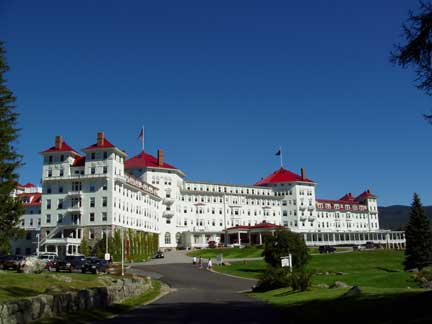 White Mountains of New Hampshire, and I fell in love. When we came around a curve in the White Mountains in a tiny town called Bretton Woods, there it was, the Mount Washington Hotel & Resort. This 1902 hotel built to cater to wealthy summer guests who arrived in private rail cars is spectacular. A bright red roof atop this brilliant white hotel grabs your eye as quickly as it grabs your heart. It sits on a hilltop surrounded by lush grounds and has a wraparound porch like Mackinac's Grand Hotel. White Mountains of New Hampshire, and I fell in love. When we came around a curve in the White Mountains in a tiny town called Bretton Woods, there it was, the Mount Washington Hotel & Resort. This 1902 hotel built to cater to wealthy summer guests who arrived in private rail cars is spectacular. A bright red roof atop this brilliant white hotel grabs your eye as quickly as it grabs your heart. It sits on a hilltop surrounded by lush grounds and has a wraparound porch like Mackinac's Grand Hotel.
The depression caused the loss of the class of people who frequented summer retreats like this in the White Mountains, but in 1944 this hotel was born again. Our government refurbished the hotel in preparation for the World Monetary Fund Conference. Here President Roosevelt met with leaders of other nations and set the gold standard at $35 an ounce, thus establishing the dollar as the cornerstone of international financial exchange. The rooms where they met and where they signed the document are now a museum inside the hotel.
The hotel was just a summer resort until very recently when it was winterized. They now have holiday packages, and Christmas there must be spectacular. So, if you, like me, are a fan of great hotels, add this one to your list.
The tiny town of Bethel had a restaurant touted as one of New England's finest, so we dined at L'auberge, and had a great dinner. We named it our "alternate" anniversary dinner because our 46th wedding anniversary dinner almost a month earlier was really awful. We were in a tiny town with no notable eating establishments, but we decided to eat out anyway, and I was sick for two days. So L'auberge was our alternate. I had grilled sea bass, the tiniest green beans, mashed potatoes topped with fried sweet potato strips, and a chocolate decadence that I shared because it was so rich--and sharing my chocolate is not something I usually do, even after 46 years!
---Return to top of page---
STRATFORD, ON, CN
With theater withdrawals occurring frequently, we decided a stop at the Stratford Shakespeare Festival was needed. First, we saw a presentation of Alexander Dumas’ The Count of Monte Cristo. The Stratford actors are so good, and by the time September rolls around, they certainly are comfortable in their roles. The performances were all sold out, so I guess other people know that, too. I love the sets here. They are some of the most innovative this side of Stratford on Avon.
The next day we saw a performance of Macbeth, a handsome, mad, sexy Macbeth whose scenes with the equally mad Lady Macbeth were extremely sensual. Great performances by all. The Shakespeare here almost equals that in that other Stratford on the other side of the Atlantic.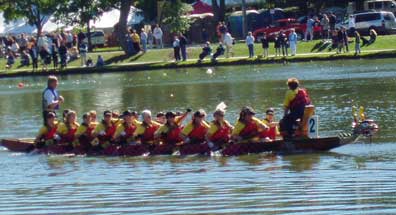
Then, on Saturday, we went to the Dragon Boat Festival. Twenty-five races of three and sometimes four "Dragon Boats" took place on the Avon. The oars people were of all ages and apparently from all walks of life. It is the fastest growing sport in Canada. Each boat must have twenty rowers, of whom at least eight must be female, a drummer and a person in the back who steers. Several teams were breast cancer survivors and other just cancer survivors. There were school age kids and participants older than we are. The day was cool, the air crisp, and we enjoyed the races and the people watching.
We spent one day at the Stratford-Perth Archives tracking down additional information on thirty plus Irish ancestors of mine who lived here in the early 19th Century. Then on Sunday we attended Mass at the church these great-great-great grandparents of mine attended. Since the church wasn't built until 1867, it wasn't the same building, but it was the same parish, because I spent a good part of the day at the archives going through the church records for information on these ancestors.
So, all in all, it was a good visit to Stratford--great theater, a new sport, some old ancestors. Not bad for a quick trip to this town.
GODERICH, ON
Less than 50 miles Northwest of Stratford is Goderich, and we chose a campground in this town to use as our base to research in various towns of Bruce County, Ontario for my family history. Work at the Bruce County Archives and several public libraries gave me more information on these Irish ancestors. Glad we had this opportunity to visit these places. From Goderich we drove to Michigan to visit our son, Paul, and his wife.
---Return to top of page---
|
October
Louisville, KY
Michigan
Ft. Wayne, IN
Chicago, IL |
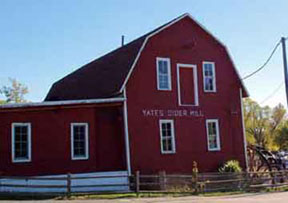 OAK PARK, MI OAK PARK, MI
Parked in the driveway of our son, Paul, and daughter-in-law, Robyn, we enjoyed visiting with them and playing with their new kitten, Maple. We all revisited Greenfield Village and generally kicked back for a few days.
LOUISVILLE, KY
The lure of the Last Hurrah for the Mid-America Square Dance Jamboree in this Kentucky Derby town was too strong to resist. We attended in 1996 and enjoyed it tremendously. Dancing with friends from California, Nevada, Illinois, Michigan, Missouri and Pennsylvania was great fun. A group of us went to Mass on Saturday evening and found the parking lot of the church absolutely full. The priest came out and told us to just park anywhere–aisles or wherever–because they had sold the parking spots to football attendees at the nearby stadium who wouldn’t return until after Mass. It was a very poor parish, and this was a way for them to supplement their income. Don’t you just love ingenuity? 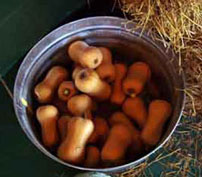
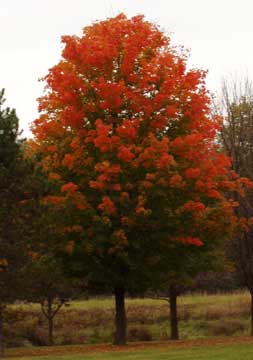 MICHIGAN MICHIGAN
We drove to Louisville from Michigan so returned to our motorhome at Paul and Robyn’s. They took us to a cider mill and to Detroit’s tremendous Eastern Market. Just imagine the largest farmer’s market you can, and you’ll have an idea of this market. A few days in Flint, Michigan allowed us to play some marathon bridge with square dance friends and to visit the largest Christmas Store in the USA at Frankenmuth. Meanwhile, the fall colors were becoming more spectacular.
FORT WAYNE, IN
The drive from sights in Michigan to this Indiana town was spectacular with color. We certainly sounded like desert dwellers as we gawked our way along the highways and byways. Our last visit to the second largest genealogical library in the United States was in 2000, and since then the Allen County Public Library has a brand new home in a modern building downtown. The facilities were excellent and the librarians well informed.
Once again we bypassed the Dan Quayle Museum and continued to Monticello, Indiana for more foliage watching and a stop at the Ford dealer to fix whatever was making the ABS light on the dashboard stay on.
---Return to top of page---
CHICAGO, IL 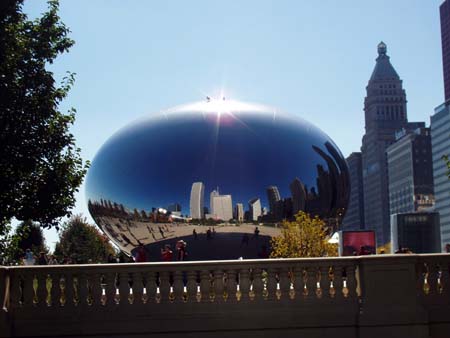
Home, sweet, home! Wow! What a difference two years makes. During our last visit Michigan Avenue was under construction, traffic was a disaster, and people were grumpy because of the traffic and the ugliness of the surrounding construction. Now there is Millennium Park, a beautiful downtown retreat adjacent to the Art Institute, resplendent with modern technology and natural beauty. The Pritzker Pavilion snakes its shiny tentacles in a wide arc from the stage to provide sound to the wide grassy area beyond the section of seats. A steel ribbon pedestrian bridge crosses from Millennium Park over Lake Shore Drive to the lakefront. A semicircular colonnade formed from two quarter-circular colonnades formerly placed in the area hold a prominent position along with a dedication to those responsible for building the park. Cloud Gate Sculpture’s stainless steel exterior reflects the city like a giant wide angle lens, and a set of brick bookend fountains about five stories high gush in varying ways to entertain those in their reflecting pool. It’s like a teckie’s dream come true.
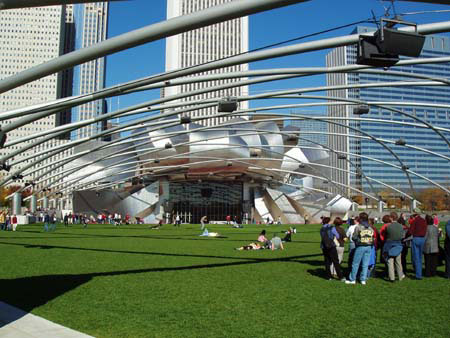 The wonderful Oriental Theater on Randolph has been renovated to its original elegance and is now the Ford Center for the Performing Arts. The Chicago Theater was renovated years ago and is a dominant feature of State Street. A new theater for music and dance on Washington Street backs up to the Pritzker Pavilion and possibly is a part of it. The wonderful Oriental Theater on Randolph has been renovated to its original elegance and is now the Ford Center for the Performing Arts. The Chicago Theater was renovated years ago and is a dominant feature of State Street. A new theater for music and dance on Washington Street backs up to the Pritzker Pavilion and possibly is a part of it.
Daley Plaza in front of Chicago’s City Hall was all gussied up for Chicagoween, complete with a huge Haunted House, a fountain spewing orange spurts, and umbrella tables sporting black umbrellas. Kids were sliding down the lower portion of the [in]famous Picasso. Revelers packed the plaza enjoying the activities and the weather.
We grabbed a burger at the Billy Goat Tavern and joined the throngs enjoying a beautiful fall day in the city. Yes, I know Thomas Wolfe said, “You can’t go home again,” and with no family in the city and very few friends still there, it still always feels like home.
---Return to top of page--- |
November
|
GILBERT, AZ When we headed the RV south and west for
Arizona, we did some heavy driving. The gasoline consumption was so
great that our credit card company called us to verify the charges
were actually ours. That 75 gallon tank on Camelot makes for a lot
of charging.
Once we arrived, it took a while to unpack Camelot and settle
things back into our long deserted home. Everything survived our
absence nicely. Houses had sprung up along the golf course next to
our home, and construction dust seeped into any openings in the
house it could find. But other than that, things were great. Square
dancing, our dinner group and computer club events began again.
By the time we settled in, it was time to leave for California
for Thanksgiving. The family gathered for this holiday because by
Christmas, Robyn will be unable to fly because the baby is due in
January. So, we had family get-togethers and attended an early
Christmas party at a friendís in Lafayette. We even had time to do a
little Christmas shopping |
December
|
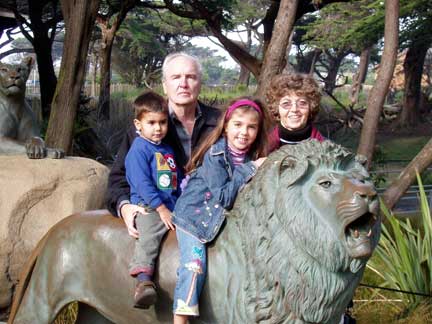
It was a treat to be able to decorate our home for the holidays.
We didnít do much in 2003 because we were in the throes of
unpacking, so we did the whole enchildada this year. We had
Christmas parties for the neighbors and for our square dance
friends; we invited family members to join us for dinner parties. It
was all very festive.
At the last minute we decided to travel to California again to
spend the holidays with the grandchildren, so we were off again. We
took some time to visit the San Francisco Zoo and visited with
every. It was a quick visit, and we returned in time for the New
Year.
---Return to top of page--- |
|
 White Mountains of New Hampshire, and I fell in love. When we came around a curve in the White Mountains in a tiny town called Bretton Woods, there it was, the Mount Washington Hotel & Resort. This 1902 hotel built to cater to wealthy summer guests who arrived in private rail cars is spectacular. A bright red roof atop this brilliant white hotel grabs your eye as quickly as it grabs your heart. It sits on a hilltop surrounded by lush grounds and has a wraparound porch like Mackinac's Grand Hotel.
White Mountains of New Hampshire, and I fell in love. When we came around a curve in the White Mountains in a tiny town called Bretton Woods, there it was, the Mount Washington Hotel & Resort. This 1902 hotel built to cater to wealthy summer guests who arrived in private rail cars is spectacular. A bright red roof atop this brilliant white hotel grabs your eye as quickly as it grabs your heart. It sits on a hilltop surrounded by lush grounds and has a wraparound porch like Mackinac's Grand Hotel.
 OAK PARK, MI
OAK PARK, MI 
 land of John Ford movies is even more striking in living color. We stayed at Goulding’s RV Park, which is part of the huge Goulding’s Lodge just five miles from the entrance to Monument Valley. A married couple settled a trading post here in 1924, coaxed John Ford to make movies here and built their own little empire. They are now both dead, but the lodge and a museum of their personal effects along with movie memorabilia are in the old trading post.
land of John Ford movies is even more striking in living color. We stayed at Goulding’s RV Park, which is part of the huge Goulding’s Lodge just five miles from the entrance to Monument Valley. A married couple settled a trading post here in 1924, coaxed John Ford to make movies here and built their own little empire. They are now both dead, but the lodge and a museum of their personal effects along with movie memorabilia are in the old trading post.  ceremonial pits. The ceremonial pits in Cliff Palace and all the other sites are amazing. They had a fire pit in the center, and on the outside they built a cold air return. The cold air came in from above, fell to the floor of the room and hit a small deflector wall in front of the vent, which sent the fresh air around the perimeter of the room. The ranger led tour is only $2.75 per person and is the bargain of the century.
ceremonial pits. The ceremonial pits in Cliff Palace and all the other sites are amazing. They had a fire pit in the center, and on the outside they built a cold air return. The cold air came in from above, fell to the floor of the room and hit a small deflector wall in front of the vent, which sent the fresh air around the perimeter of the room. The ranger led tour is only $2.75 per person and is the bargain of the century. 
 love story!
love story! 

 has Romanesque arches, another has gothic arches, and the third, known as the million dollar staircase, is designed after the one in the Paris Opera House. The one at the Opera House is gorgeous, but this one is just ornate and heavy looking. Everything in the building is dark and heavy.
has Romanesque arches, another has gothic arches, and the third, known as the million dollar staircase, is designed after the one in the Paris Opera House. The one at the Opera House is gorgeous, but this one is just ornate and heavy looking. Everything in the building is dark and heavy. 





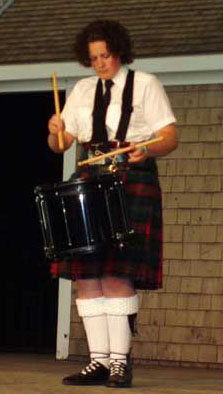

 Company, which included Ben Franklin as a shareholder, sent six families to settle some land they owned in Pictou. Four families later moved away, but in 1773 the new agent for the Philadelphia Company offered free passage, a farm lot and a year's provisions to citizens of Scotland for settling the new land. Subsequently thirty-three families and twenty-five single men boarded the Ship Hector and sailed to Nova Scotia. This was the beginning of the Scottish migration.
Company, which included Ben Franklin as a shareholder, sent six families to settle some land they owned in Pictou. Four families later moved away, but in 1773 the new agent for the Philadelphia Company offered free passage, a farm lot and a year's provisions to citizens of Scotland for settling the new land. Subsequently thirty-three families and twenty-five single men boarded the Ship Hector and sailed to Nova Scotia. This was the beginning of the Scottish migration. 
 In Iona we visited the Highland Village Living History Museum. These museums are quite plentiful throughout the U.S. and Canada, but sometimes they have something that appeals to us, as did this one. It was interesting to see the Black House of 18th century Scotland--a stone building with a sod roof. The other buildings had been moved to the site for the museum and were constructions from 1810 to 1920. The church just arrived last November, and they had photos of it being transported via various means, including on a barge in the lake.
In Iona we visited the Highland Village Living History Museum. These museums are quite plentiful throughout the U.S. and Canada, but sometimes they have something that appeals to us, as did this one. It was interesting to see the Black House of 18th century Scotland--a stone building with a sod roof. The other buildings had been moved to the site for the museum and were constructions from 1810 to 1920. The church just arrived last November, and they had photos of it being transported via various means, including on a barge in the lake.  Ray found waterfalls we could hike to on the trails and even one just outside of Baddeck where we stayed for five days. He has a fascination for waterfalls, so we follow every sign we see to one. Of course, in August, sometimes you just get to see a trickle.
Ray found waterfalls we could hike to on the trails and even one just outside of Baddeck where we stayed for five days. He has a fascination for waterfalls, so we follow every sign we see to one. Of course, in August, sometimes you just get to see a trickle. 

 Twelve acres which include over 50 buildings have been reconstructed according to the original specifications in building the fortress. Over three million pages of original document from French records were used to erect the fortress. Only nails, locks and railings made onsite by the blacksmiths were used in the building. The French were so anal that they specified where the nails in the city gate were to be placed, and this was authentically replicated.
Twelve acres which include over 50 buildings have been reconstructed according to the original specifications in building the fortress. Over three million pages of original document from French records were used to erect the fortress. Only nails, locks and railings made onsite by the blacksmiths were used in the building. The French were so anal that they specified where the nails in the city gate were to be placed, and this was authentically replicated.  We had lunch at one of the three restaurants where only pewter dishes and utensils were used. Everyone was seated at wooden benches with huge towel-like napkins. We had some split pea soup and bread made at one of the bakeries. The soup was tasty, and the bread was a very heavy dark bread, the kind the soldiers would get in their weekly rations. They got about a six pound loaf, which would get very hard after a few days, so they needed to dip it into some liquid to soften it in order to eat it. Anyway, back to our lunch. The pewter spoons with our soup were huge, and when the woman next to us inquired about a spoon for the open bowl of raw sugar for her tea, the waitress showed her how to use the handle end to scoop some sugar. Didn’t seem very sanitary to me.
We had lunch at one of the three restaurants where only pewter dishes and utensils were used. Everyone was seated at wooden benches with huge towel-like napkins. We had some split pea soup and bread made at one of the bakeries. The soup was tasty, and the bread was a very heavy dark bread, the kind the soldiers would get in their weekly rations. They got about a six pound loaf, which would get very hard after a few days, so they needed to dip it into some liquid to soften it in order to eat it. Anyway, back to our lunch. The pewter spoons with our soup were huge, and when the woman next to us inquired about a spoon for the open bowl of raw sugar for her tea, the waitress showed her how to use the handle end to scoop some sugar. Didn’t seem very sanitary to me.  A guitar playing entertainer gathered a ring of children and townsfolk around and lead them in a rousing rendition of alouette, which everyone enjoyed.
A guitar playing entertainer gathered a ring of children and townsfolk around and lead them in a rousing rendition of alouette, which everyone enjoyed.  The French influence was even more evident here than in the rest of the town.
The French influence was even more evident here than in the rest of the town. 



 The Old Burying Ground was used from 1749 to 1844 which is pretty old for North America. A foundation recently restored the cemetery and straightened all the remaining tombstones. It sits in the downtown area with St. Mary's Roman Catholic Basilica on one border and St. Matthew's United Church on another. St. Mary's has the tallest polished granite spire in North America and was built in the mid 19th century, and St. Matthew's opened in 1859, but its congregation dates to 1749.
The Old Burying Ground was used from 1749 to 1844 which is pretty old for North America. A foundation recently restored the cemetery and straightened all the remaining tombstones. It sits in the downtown area with St. Mary's Roman Catholic Basilica on one border and St. Matthew's United Church on another. St. Mary's has the tallest polished granite spire in North America and was built in the mid 19th century, and St. Matthew's opened in 1859, but its congregation dates to 1749.  such stinkers. We never attacked it, and neither did anyone else, but it is an imposing place. The 19th century accommodations didn’t seem a great deal better than the 18th century ones we saw at Louisbourg, but maybe I was missing the fine points. The sanitary conditions in both centuries make me wonder how any of us were ever born.
such stinkers. We never attacked it, and neither did anyone else, but it is an imposing place. The 19th century accommodations didn’t seem a great deal better than the 18th century ones we saw at Louisbourg, but maybe I was missing the fine points. The sanitary conditions in both centuries make me wonder how any of us were ever born. 


 Common Land was subdivided and wealthy merchants and professionals built fashionable homes there. Hence, in 1995 the pretty town as designated a UNESCO World Heritage Site because it is an outstanding example of a planned European colonial settlement. We did a walking tour of the town and enjoyed the 18th and 19th century buildings. Atop a hill at the edge of town sits the impressive 1895 Lunenburg Academy. The wood frame structure is three stories high and is visible for many miles.
Common Land was subdivided and wealthy merchants and professionals built fashionable homes there. Hence, in 1995 the pretty town as designated a UNESCO World Heritage Site because it is an outstanding example of a planned European colonial settlement. We did a walking tour of the town and enjoyed the 18th and 19th century buildings. Atop a hill at the edge of town sits the impressive 1895 Lunenburg Academy. The wood frame structure is three stories high and is visible for many miles.  here until 1921 when he contracted polio and had to be carried off the island on a stretcher. The 34 room Roosevelt Cottage is now part of Roosevelt Campobello International Park, a joint memorial by Canada and the United States which opened in 1964.
here until 1921 when he contracted polio and had to be carried off the island on a stretcher. The 34 room Roosevelt Cottage is now part of Roosevelt Campobello International Park, a joint memorial by Canada and the United States which opened in 1964. 


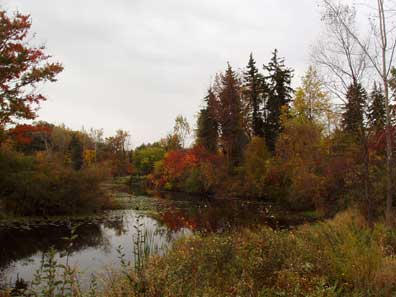
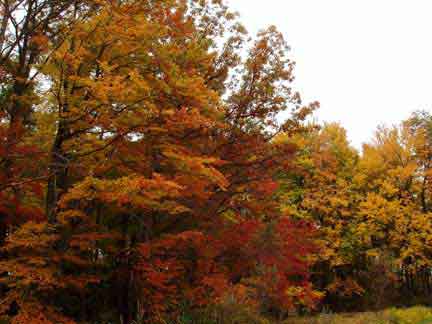

 The wonderful Oriental Theater on Randolph has been renovated to its original elegance and is now the Ford Center for the Performing Arts. The Chicago Theater was renovated years ago and is a dominant feature of State Street. A new theater for music and dance on Washington Street backs up to the Pritzker Pavilion and possibly is a part of it.
The wonderful Oriental Theater on Randolph has been renovated to its original elegance and is now the Ford Center for the Performing Arts. The Chicago Theater was renovated years ago and is a dominant feature of State Street. A new theater for music and dance on Washington Street backs up to the Pritzker Pavilion and possibly is a part of it.